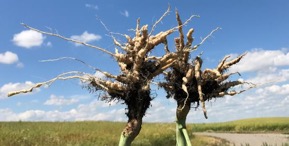Is Club Root Becoming a Serious Soil Health Problem in North Dakota?
Club root is a soil-borne disease pathogen that infects roots of canola (Figure 1) and other crops of the brassica family (cabbage, collards, radish, turnip, etc.).
It is becoming a serious concern in canola producing areas, especially in northeast North Dakota.
Why is there concern?
Dr. V. Chapara at the NDSU Langdon Research Extension Center is leading disease scouting efforts of club root in several northeast counties. He has recently shown that there are more infected areas today than five years ago.
The disease is hard to manage because it produces spores that can live in the soil for as long as 20 years. Eradication of the disease-causing pathogens from an infected field is reported to be impossible.
It is not yet known how cover crop mixes that contain brassica seed like radishes and turnips will affect persistence of the disease pathogen.
How can you identify infected cropland?
- Scout fields regularly (plants are stunted, wilting, yellowing, premature ripening of pods)
- Aboveground part of diseased plants resembles nutrient deficient plants
- Uproot plants and observe for any root galls (Figure 1)

Figure 1. Club root of canola plant (Photo courtesy of Dr. Venkat Chapara).
How can you management it?
- Avoid planting canola in low pH soils, where club root has been identified
- Rotate canola with non-brassica crops, for at least five years
- Plant club root resistant varieties
- Prevent growth of weeds from the brassica family (e.g., wild mustard)
- Clean and disinfect field equipment and footwear after passing through an infected field
- Liming to raise soil pH to above neutral (> pH 7) though this warrants more research
NOTE: Suspected fields can be soil sampled and sent to a commercial lab for testing.
Jasper M Teboh, Ph. D.
Jasper.Teboh@ndsu.edu
Research Soil Scientist


